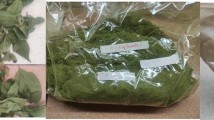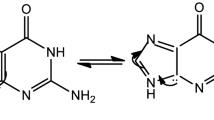Abstract
A novel series of complexes ML(ClO4)·nH2O (M: Co, Ni, Cu, Zn; HL: 2-[(E)-(1H-1,2,4-triazol-3-ylimino)methyl]phenol) have been synthesized and characterized as mononuclear species. The features of complexes have been assigned from microanalytical, FAB-MS, IR, UV–Vis-NIR, EPR and magnetic data. The IR spectra indicate the chelate behaviour of Schiff base and the perchlorate presence either as free ion or as ligand. Electronic and magnetic data are consistent with hexa-coordination of Co(II) and Ni(II) and penta-coordination for Cu(II) ions in complexes. The simultaneous TG-DSC/MS measurements evidenced processes as water (hydration or coordination) elimination, perchlorate decomposition as well as Schiff base both fragmentation and oxidative degradation. The in vitro screening of the antimicrobial behaviour on Gram-positive and Gram-negative bacteria, as well as on fungal strains, indicates a good activity for Cu(II) and Zn(II) complexes against both planktonic or adherent cells. Moreover, Cu(II) complex also exhibited a promising antiproliferative activity on HT 29 cell line.






Similar content being viewed by others
References
Glinel K, Thebault P, Humblot V, Pradier CM, Jouenne T. Antibacterial surfaces developed from bio-inspired approaches. Acta Biomater. 2012;8:1670–84.
Böttcher T, Kolodkin-Gal I, Kolter R, Losick R, Clardy J. Synthesis and activity of biomimetic biofilm disruptors. J Am Chem Soc. 2013;135:2927–30.
Lazar V. Microbial adherence. Bucharest: Romanian Academy Publishing House; 2003.
Di Santo A, Gil DM, Pomiro F, Piro OE, Echeverría GA, Arena M, Luciardi C, Carbonio RE, Ben Altabef A. Biofilm inhibition by a new Mn(II) complex with sulfamethoxazole: synthesis, spectroscopic characterization and crystal structure. Inorg Chim Acta. 2015;436:16–22.
Usman M, Arjmand F, Ahmad M, Shavez Khan M, Ahmad I, Tabassum S. A comparative analyses of bioactive Cu(II) complexes using Hirshfeld surface and density functional theory (DFT) methods: DNA binding studies, cleavage and antibiofilm activities. Inorg Chim Acta. 2016;453:193–201.
Viganor L, Galdino ACM, Nunes APF, Santos KRN, Branquinha MH, Devereux M, Kellett A, McCann M, Santos ALS. Anti-Pseudomonas aeruginosa activity of 1,10-phenanthroline-based drugs against both planktonic- and biofilm-growing cells. J Antimicrob Chemother. 2016;71:128–34.
Badea M, Vlaicu ID, Olar R, Constand M, Bleotu C, Chifiriuc MC, Marutescu L, Lazar V, Grecu MN, Marinescu D. Thermal behaviour and characterisation of new biologically active Cu(II) complexes with benzimidazole as main ligand. J Therm Anal Calorim. 2014;118:1119–33.
Vlaicu ID, Constand M, Olar R, Marinescu D, Grecu MN, Lazar V, Chifiriuc MC, Badea M. Thermal stability of new biologic active copper (II) complexes with 5,6-dimethylbenzimidazole. J Therm Anal Calorim. 2013;113:1369–77.
Badea M, Calu L, Chifiriuc MC, Bleotu C, Marin A, Ion S, Ioniţă G, Stanică N, Măruţescu L, Lazăr V, Marinescu D, Olar R. Thermal behaviour of some novel antimicrobials based on complexes with a Schiff base bearing 1,2,4-triazole pharmacophore. J Therm Anal Calorim. 2014;118:1145–57.
Calu L, Badea M, Chifiriuc MC, Bleotu C, David GI, Ioniţă G, Măruţescu L, Lazăr V, Stanică N, Soponaru I, Marinescu D, Olar R. Synthesis, spectral, thermal, magnetic and biological characterization of Co(II), Ni(II), Cu(II) and Zn(II) complexes with a Schiff base bearing a 1,2,4-triazole pharmacophore. J Therm Anal Calorim. 2015;120:375–86.
Olar R, Calu L, Badea M, Chifiriuc MC, Bleotu C, Velescu B, Stoica O, Ioniţă G, Stanică N, Silvestro L, Dulea C, Uivarosi V. Thermal behaviour of some biologically active species based on complexes with a triazolopyrimidine pharmacophore. J Therm Anal Calorim. 2017;127:685–96.
Calu L, Badea M, Cerc Korošec R, Bukovec P, Daniliuc CG, Chifiriuc MC, Măruţescu L, Ciulică C, Şerban G, Olar R. Thermal behaviour of some novel biological active complexes with a triazolopyrimidine pharmacophore. J Therm Anal Calorim. 2017;127:697–708.
Bukonjić AM, Tomović DLJ, Nikolić MV, Mijajlović MZ, Jevtić VV, Ratković ZR, Novaković SB, Bogdanović GA, Radojević ID, Maksimović JZ, Vasić SM, Čomić LR, Trifunović SR, Radić GP. Antibacterial, antibiofilm and antioxidant screening of copper(II)-complexes with some S-alkyl derivatives of thiosalicylic acid. Crystal structure of the binuclear copper(II)-complex with S-propyl derivative of thiosalicylic acid. J Mol Struct. 2017;1128:330–7.
Gandra RM, Mc Carron P, Fernandes MF, Ramos LS, Mello TP, Aor AC, Branquinha MH, McCann M, Devereux M, Santos ALS. Antifungal potential of Copper(II), Manganese(II) and Silver(I) 1,10-phenanthroline chelates against multidrug-resistant fungal species forming the Candida haemulonii complex: impact on the planktonic and biofilm lifestyles. Front Microbiol. 2017;8:1–11.
Olar R, Vlaicu ID, Chifiriuc MC, Bleotu C, Stanică N, Vasile Scăeţeanu G, Silvestro L, Dulea C, Badea M. Synthesis, thermal analysis and biological characterisation of some new nickel (II) complexes with unsaturated carboxylates and heterocyclic N-donor ligands. J Therm Anal Calorim. 2017;127:731–41.
Tyagi P, Chandra S, Saraswat BS, Yadav D. Design, spectral characterization, thermal, DFT studies and anticancer cell line activities of Co(II), Ni(II) and Cu(II) complexes of Schiff bases derived from 4-amino-5-(pyridin-4-yl)-4H-1,2,4-triazole-3-thiol. Spectrochim Acta A Mol Biomol Spectrosc. 2015;145:155–64.
Ding Y, Zhang Z, Zhang G, Mo S, Li Q, Zhao Z. Green synthesis and evaluation of the antitumor activity of a novel series of 3-[4-bi-(4-fluorophenyl)methylpiperazinyl]-4-amino-5-thione-1,2,4-triazole Schiff bases. Res Chem Intermed. 2016;42:3105–16.
Kandile NG, Mohamed MI, Ismaeel HM. Synthesis of new Schiff bases bearing 1,2,4-triazole, thiazolidine and chloroazetidine moieties and their pharmacological evaluation. J Enzym Inhib Med Chem. 2017;32:119–29.
Deodware SA, Sathe DJ, Choudhari PB, Lokhande TN, Gaikwad SH. Development and molecular modeling of Co(II), Ni(II) and Cu(II) complexes as high acting antibreast cancer agents. Arab J Chem. 2017;10:262–72.
Tyagi P, Tyagi M, Agrawal S, Chandra S, Ojha H, Pathak M. Synthesis, characterization of 1,2,4-triazole Schiff base derived3d-metal complexes: induces cytotoxicity in HepG2, MCF-7 cell line, BSA binding fluorescence and DFT study. Spectrochim Acta A Mol Biomol Spectrosc. 2017;171:246–57.
Baluja S, Chanda S, Godvani N. Synthesis and antibacterial studies of some metal chelates of 1,2,4-triazole Schiff bases. Pharm Chem J. 2015;48:797–801.
Alaghaz A-NMA, Zayed ME, Alharbi SA. Synthesis, spectral characterization, molecular modeling, biological activity and potentiometric studies of 4-amino-5-mercapto-3-methyl-S-triazole Schiff’s base complexes. J Mol Struct. 2015;1083:430–40.
Alaghaz A-NMA, Zayed ME, Alharbi SA, Ammar RAA, Chinnathambi A. Synthesis, spectroscopic identification, thermal, potentiometric andantibacterial activity studies of 4-amino-5-mercapto-S-triazole Schiff’s base complexes. J Mol Struct. 2015;1087:60–7.
Utthra PP, Kumaravel G, Raman N. Screening the efficient biological prospects of triazole allied mixed ligand metal complexes. J Mol Struct. 2017;1150:374–82.
Pokharia M, Yadav SK, Mishra H, Pandey N, Tilak R, Pokharia S. Synthesis, spectroscopic characterization, biological activity and theoretical studies of (E)-N3-(2-chlorobenzylidene)-H-1,2,4-triazole-3,5-diamine. J Mol Struct. 2017;1144:324–37.
Nassar MY, Aly HM, Moustafa ME, Abdelrahman EA. Synthesis, characterization and biological activity of new 3-substitued-4-amino-5-hydrazino-1,2,4-triazole Schiff bases and their Cu(II) complexes: a new approach to CuO nanoparticles for photocatalytic degradation of methylene blue dye. J Inorg Organomet Polym Mater. 2017;27:1220–33.
Singh K, Kumar Y, Puri P, Sharma C, Aneja KR. Antimicrobial, spectral and thermal studies of divalent cobalt, nickel, copper and zinc complexes with triazole Schiff bases. Arab J Chem. 2017;10:S978–87.
Ünver Y, Deniz S, Çelik F, Küçük M, Sancak K, Akar Z. Synthesis of new 1,2,4-triazole compounds containing Schiff and Mannich bases (morpholine) with antioxidant and antimicrobial activities. J Enzym Inhib Med Chem. 2017;31:89–95.
Jithendra Kumara KS, Krishnamurthy G, Sunil K. Synthesis, characterization, in vitro antimicrobial, anthelmintic and docking studies of new 2-[(E)-{[4-(1H-1,2,4-triazol-1 ylmethyl)phenyl]imino}methyl]phenol, and their complexes with 3d metal ions. Int J Pharm Pharm Sci. 2016;8:134–9.
Aromia G, Barriosa LA, Roubeaub O, Gamez P. Triazoles and tetrazoles: prime ligands to generate remarkable coordination Materials. Coord Chem Rev. 2011;255:485–546.
Zhou C-H, Wang Y. Recent researches in triazole compounds as medicinal drugs. Cur Med Chem. 2012;19:239–80.
Geary WJ. The use of conductivity measurements in organic solvents for the characterisation of coordination compounds. Coord Chem Rev. 1971;7:81–122.
Nakamoto K. Infrared and Raman spectra of inorganic and coordination compounds. New York: Wiley; 1986.
Hathaway BJ. Oxyanions. In: Wilkinson G, Gillard RD, McCleverty JA, editors. Comprehensive coordination chemistry. New York: Pergamon Press; 1987.
Solomon EI, Lever ABP. Inorganic electronic structure and spectroscopy, applications and case studies, vol. II. New York: Wiley; 2006.
Gispert JR. Coordination chemistry. Weinheim: Wiley; 2008.
Smtih TD, Pilbrow JR. The determination of structural properties of dimeric transition metal ion complexes from EPR spectra. Coord Chem Rev. 1974;13:173–278.
Uivarosi V, Badea M, Olar R, Drǎghici C, Bǎrbuceanu ŞF. Synthesis and characterization of some new complexes of magnesium (II) and zinc (II) with the natural flavonoid primuletin. Molecules. 2013;18:7631–45.
Bartyzel A. Synthesis, thermal study and some properties of N2O4-donor Schiff base and its Mn(III), Co(II), Ni(II), Cu(II) and Zn(II) complexes. J Therm Anal Calorim. 2017;127:2133–47.
Clinical Laboratory Standards Institute. M100. Performance standard for antimicrobial susceptibility testing. 28th Ed. Pennsylvania: Wayne; 2018.
Clinical Laboratory Standards Institute. M60. Performance standard for antifungal susceptibility testing of yeasts. 1st Ed. Pennsylvania: Wayne; 2018.
Nuta DC, Măruțescu L, Missir AV, Morusciag L, Chirita C, Curutiu C, Badiceanu C, Papacocea MT, Limban C. In vitro evaluation of the antimicrobial activity of N-phenylcarbamothioyl benzamides against planktonic and adherent microbial cells. Romanian Biotechnol Lett. 2017;22:13163–8.
Telcian A, Mohammed DH, Chifiriuc MC, Bleotu C, Holban AM, Curutiu C, Grosu E, Ficai A, Mihaescu G, Grigore R, Ditu LM. Asessment of the anti-biofilm activity and biocompatibility of novel PE and PVC polymers. Romanian Biotechnol Lett. 2017;22:12997–3004.
Popa M, Hussien MD, Cirstea A, Lazar V, Bezirtzoglou E, Chifiriuc MC, Sakizlian M, Stavropoulou E, Bertesteanu S. Insights on metal based dental implants and their interaction with the surrounding tissues. Cur Top Med Chem. 2015;15:1614–21.
Bertesteanu SVG, Popescu CR, Grigore R, Popescu B. Pharyngoesophageal junction neoplasia—therapeutic management. Chirurgia. 2012;107:33–8.
Acknowledgements
The authors thank researcher Gabriela Ionită from “Ilie Murgulescu” Physical Chemistry Institute of Romanian Academy for EPR measurements.
Author information
Authors and Affiliations
Corresponding author
Rights and permissions
About this article
Cite this article
Calu, L., Badea, M., Čelan Korošin, N. et al. Spectral, thermal and biological characterization of complexes with a Schiff base bearing triazole moiety as potential antimicrobial species. J Therm Anal Calorim 134, 1839–1850 (2018). https://doi.org/10.1007/s10973-018-7871-x
Received:
Accepted:
Published:
Issue Date:
DOI: https://doi.org/10.1007/s10973-018-7871-x




